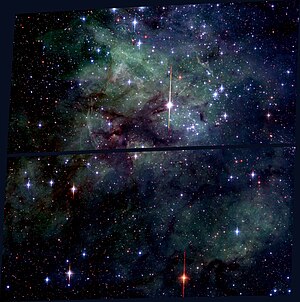NGC 2060
| Supernova remnant | |
|---|---|
| NGC 2060 | |

|
|
| NGC 2060, image taken by the Hubble Space Telescope | |
| Constellation | Swordfish |
|
Position equinox : J2000.0 |
|
| Right ascension | 05h 37m 46.9s |
| declination | -69 ° 10 ′ 18 ″ |
| Further data | |
| Brightness (visual) |
9.6 likes |
| Brightness (B-band) |
9.7 likes |
| Angular expansion |
3.1 '× 2.4' |
| distance |
173,000 ly |
| Affiliation | |
| diameter | 156 ly |
| history | |
| discovery | |
| Date of discovery |
Late 1836 to early 1837 |
| Catalog names | |
| NGC 2060 • ESO 57-EN1 • IRAS 05381-6912 • 30 Doradus B • N157B | |
| Aladin previewer | |
NGC 2060 is an astronomical nebula that results from the remains of a star explosion, a supernova remnant similar to the Crab Nebula . It is located in the Tarantula Nebula in the constellation Swordfish and is listed in the New General Catalog . It was discovered by John Herschel between late 1836 and early 1837 .
Inside, a pulsar (PSR J0537-6910) with a period of 16 ms was discovered in 1998 , which was also formed from the star during the supernova 5000 years ago.
Web links
- SIMBAD : NGC 2060
- Supernova Remnants in the Large Magellanic Cloud
- FE Marshall, EV Gotthelf, W. Zhang, J. Middleditch, QD Wang: Discovery of an Ultrafast X-Ray Pulsar in the Supernova Remnant N157B , Astrophysical Journal, 499: L179-L182, 1998